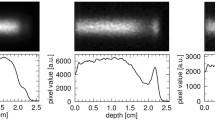Abstract
Proton therapy is a form of radiotherapy that enables concentration of dose on a tumor by use of a scanned or modulated Bragg peak. Therefore, it is very important to evaluate the proton-irradiated volume accurately. The proton-irradiated volume can be confirmed by detection of pair-annihilation gamma rays from positron-emitting nuclei generated by the nuclear fragmentation reaction of the incident protons on target nuclei using a PET apparatus. The activity of the positron-emitting nuclei generated in a patient was measured with a PET-CT apparatus after proton beam irradiation of the patient. Activity measurement was performed in patients with tumors of the brain, head and neck, liver, lungs, and sacrum. The 3-D PET image obtained on the CT image showed the visual correspondence with the irradiation area of the proton beam. Moreover, it was confirmed that there were differences in the strength of activity from the PET-CT images obtained at each irradiation site. The values of activity obtained from both measurement and calculation based on the reaction cross section were compared, and it was confirmed that the intensity and the distribution of the activity changed with the start time of the PET imaging after proton beam irradiation. The clinical use of this information about the positron-emitting nuclei will be important for promoting proton treatment with higher accuracy in the future.








Similar content being viewed by others
References
Chu WT, Ludewigt BA, Renner TR. Instrumentation for treatment of cancer using proton and light-ion beams. Rev Sci Instrum. 1993;64(8):2055–122.
Bennett GW, Goldberg A, Levine G, Guthy J, Balsamo J. Beam localization via 15O activation in proton radiation therapy. Nucl Instr Meth. 1975;125:333–8.
Bennett GW, Archambeau JO, Archambeau BE, Meltzer JI, Wingate CL. Visualization and transport of positron emission from proton activation in vivo. Science. 1978;200:1151–3.
Oelfke U, Lam G, Atkins M. Proton dose monitering with PET: quantiative studies in Lucite. Phys Med Biol. 1996;41:177–96.
Litzenberg DW, Roberts DA, Lee MY, Pham K, Vander Molen AM, Ronningen R, et al. On-line monitoring of radiotherapy beams: experimental results with proton beams. Med Phys. 1999;26(6):992–1006.
Parodi K, Enghardt W. Potential application of PET in quality assuarnce of proton therapy. Phys Med Biol. 2000;45:N151–6.
Nishio T, Ogino T, Shimbo M, Katsuta S, Kawasaki S, Murakami T, et al. Distributions of β+ decayed nucleus produced from the target fragment reaction in (CH2) n and patient liver targets by using a proton beam for therapy. Abstracts of the XXXIV PTCOG MEETING in Boston; 2001. pp. 15–6.
Parodi K, Enghardt W, Haberer T. In-beam PET measurements of β+ radioactivity induced by proton beams. Phys Med Biol. 2002;47:21–36.
Hishikawa Y, Kagawa K, Murakami M, Sasaki H, Akagi T, Abe M. Usefulness of positron-emission tomographic images after proton therapy. Int J Rad Oncol Biol Phys. 2002;53:1388–91.
Enghardt W, Crespo P, Fiedler F, Hinz R, Parodi K, Pawelke J, et al. Dose quantification from in-beam positron emission tomography. Radiother Oncol. 2004;73(Suppl. 2):S96–8.
Nishio T, Sato T, Kitamura H, Murakami K, Ogino T. Distributions of β+ decayed nuclei generated in the CH2 and H2O targets by the target nuclear fragment reaction using therapeutic MONO and SOBP proton beam. Med Phys. 2005;32(4):1070–82.
Parodi K, Ponisch F, Enghardt W. Experimental study on the feasibility of in-beam PET for accurate monitoring of proton therapy. IEEE Trans Nucl Sci. 2005;52:778–86.
Nishio T, Ogino T, Nomura K, Uchida H. Dose-volume delivery guided proton therapy using beam ON-LINE PET system. Med Phys. 2006;33(11):4190–7.
Photon, Electron, Proton and Neutron Interaction Data for Body Tissues (ICRU Report 46). pp. 11–3.
Iljinov AS, Semenov VG, Semenova MP, Schopper H. Interactions of protons with nuclei (supplement to I/13a, b, c), (Landolt-Bornstein New Series. 1994).
Goldharber AS. Statistical models of fragmentation processes. Phys Lett. 1974;53B:306–8.
Winger A, Sherrill BM. Morrissey. INTENSITY: acomputer program for the estimation of secondary beam intensities from a projectile fragment separator. Nucl Instrum Methods. 1992;B70:380–92.
Nishio T. Proton therapy facility at National Cancer Center, Kashiwa, Japan. J At Energy Soc. 1999;41(11):1134–8.
Tachikawa T, Sato T, Ogino T, Nishio T. Proton treatment devices at National Cancer Center (Kashiwa). Radiat Indust. 1999;84:48–53.
Nishio T, Kataoka S, Tachibana M, Matsumura K, Uzawa N, Saito H, et al. Development of a simple control system for unifom proton dose distribution in a dual-ring double scattering system. Phys Med Biol. 2006;51:1249–60.
Nishio T, Ogino T, Sakudo M, Tanizaki N, Yamada M, Nishida G, et al. Present proton treatment planning system at National Cancer Center Hospital East. Jpn J Med Phys Proc. 2000;20(Suppl. 4):174–7.
Boellaard R, Lingen AV, Lammertsma AA. Experimental and clinical evaluation of iterative reconstruction (OSEM) in dynamic PET: quantitative characteristics and effects on kinetic modeling. J Nucl Med. 2001;42:808–17.
Tomitani T, Pawelke J, Kanazawa M, Yoshikawa K, Yoshida K, Sato M, et al. Washout studies of 11C in rabbit thigh muscle implanted by secondary beams of HIMAC. Phys Med Biol. 2003;48:875–89.
Mizuno H, Tomitani T, Kanazawa M, Kitagawa A, Pawelke J, Iseki Y, et al. Washout measurement of radioisotope implanted by radioactive beams in the rabbit. Phys Med Biol. 2003;48:2269–81.
Acknowledgments
We greatly thank the staff members of the Proton Radiotherapy Department of the National Cancer Center, Kashiwa, for their assistance, and the members of SHI Accelerator Service Ltd. and Accelerator Engineering Inc. for operation of the proton apparatus. We are grateful to the reviewers and editors of this Journal for their comments and advices, and thank the other office staffs for their supports.
Author information
Authors and Affiliations
Corresponding author
About this article
Cite this article
Nishio, T., Miyatake, A., Inoue, K. et al. Experimental verification of proton beam monitoring in a human body by use of activity image of positron-emitting nuclei generated by nuclear fragmentation reaction. Radiol Phys Technol 1, 44–54 (2008). https://doi.org/10.1007/s12194-007-0008-8
Received:
Revised:
Accepted:
Published:
Issue Date:
DOI: https://doi.org/10.1007/s12194-007-0008-8




